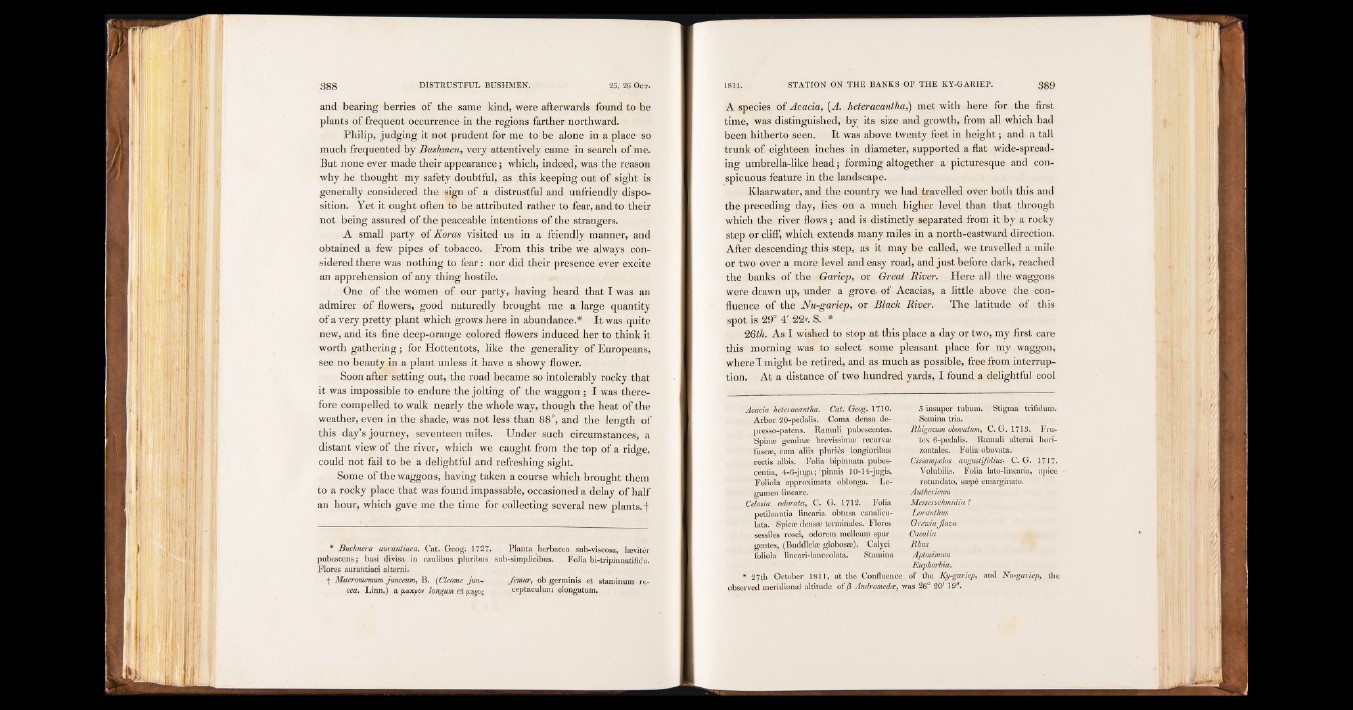
and bearing berries of the same kind, were afterwards found to be
plants of frequent occurrence in the regions farther northward.
Philip, judging it not prudent for me to be alone in a place so
much frequented by Bushmen, very attentively came in search of me.
But none ever made their appearance; which, indeed, was the reason
why he thought my safety doubtful, as this keeping out of sight is
generally considered the sign of a distrustful and unfriendly disposition.
Yet it ought often to be attributed rather to fear, and to their
not being assured of the peaceable intentions of the strangers.
A small party of Koras visited us in a friendly manner, and
obtained a few pipes of tobacco. From this tribe we always considered
there was nothing to fear: nor did their presence ever excite
an apprehension of any thing hostile.
One of the women of our party, having heard that I was an
admirer of flowers, good naturedly brought me a large quantity
of a very pretty plant which grows here in abundance.* It was quite
new, and its fine deep-orange colored flowers induced her to think it
worth gathering; for Hottentots, like the generality of Europeans,
see no beauty in a plant unless it have a showy flower.
Soon after setting out, the road became so intolerably rocky that
it was impossible to endure the jolting of the waggon ; I was therefore
compelled to walk nearly the whole way, though the heat of the
weather, even in the shade, was not less than 88°, and the length of
this day’s journey, seventeen miles. Under such circumstances, a
distant view of the river, which we caught from the top of a ridge,
could not fail to be a delightful and refreshing sight.
Some of the waggons, having taken a course which brought them
to a rocky place that was found impassable, occasioned a delay of half
an hour, which gave me the time for collecting several new plants, f
* Budinera aurantiaca. Cat. Geog. 1727. Planta herbácea sub-viscósa, leevitér
pubescens ; basi divisa in caulibus pluribus sub-simplicibus. Folia bi-tripinnatifida.
Flores aurantiaci alterni,
f Macromcmum junceum, B. (Cleome ju n - fémur, ob germinis et staminum recea.
Linn.) a ¡uixfiov longum et pr¡§o¡ ceptaculum elongatum.
A species of Acacia, (A. heteracantha,) met with here for the first
time, was distinguished, by its size and growth, from all which had
been hitherto seen. It was above twenty feet in height; and a tall
trunk of eighteen inches in diameter, supported a flat wide-spreading
umbrella-like head; forming altogether a picturesque and conspicuous
feature in the landscape.
Klaarwater, and the country we had travelled over both this and
the preceding day, lies on a much higher level than that through
which the river flows; and is distinctly separated from it by a rocky
step or cliff, which extends many miles in a north-eastward direction.
After descending this step* as it may be called, we travelled a mile
or two over a more level and easy road, and just before dark, reached
the banks of the Gariep, or Great River. Here all the waggons
were drawn up, under a grove, of Acacias, a little above the confluence
of the Nu-gariep, or Black River. The latitude of this
spot is 29° 4' 22». S. *
26th. As I wished to stop at this place a day or two, my first care
this morning was to select some pleasant place for my waggon,
where I might be retired, and as much as possible, free from interruption.
At a distance of two hundred yards, I found a delightful cool
Acacia heteracantha. Cat. Geog. 1710. 5 insuper tubum. Stigma trifidum.
Arbor 20-pedalis. Coma densa de- Semina tria.
presso-patens. Ramuli pubescentes. fihigozum obovatum, C. G. 1713. Fru-
Spinm geminas brevissima recufvae tex 6-pedalis. Ramuli alterni horifuscte,
cum aliis pluriès longioribus zontales. Folia obovata.
rectis albis. Folia bipinnata pubes- Cissampelos ajigustifolius. C. G. 1717.
centia, 4-6-juga; Jpinnis 10-14-jugis. Volubilis. Folia lato-linearia, apice
Folíola approximata oblonga. Le- rotondato, ssepè emarginato,
gumen lineare. Anthei'ìcim
Ceiosia odorata, C. G. 1712. Folia Messerschmidia ?
petiloantia linearia obtusa canalicu- Lordnthus
lata. Spicae densas terminales. Flores Gretolafava
sessiles rosei, odorem melleum spar Cacalia
gentes, (Buddleias globosas). Calyci Rhus
folíola lineari-lanceolata. Stamina Aptosimum
Euphorbia.
* 27th October 1811, at the Confluence, of the Ky-.rr/t.'ron on/1 ndjl—r rm 'i